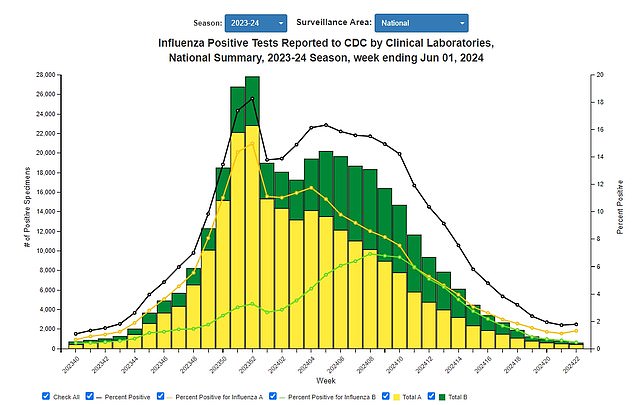CDC warns that two Americans have been infected with ‘double mutant’ strains of flu that are immune to some drugs
A ‘dual mutant’ flu virus has been discovered in the US that could make medicines less effective, officials warn.
At least two Americans were infected last flu season with a new H1N1 strain that contains two new major mutations, a study found, in a warning sign that the strain could take hold.
Around the world, 101 cases were detected out of 15,000 infections analyzed – or 0.67 percent – across five continents, which is another sign that it is spreading.
Scientists at the CDC call the strain a “double mutant” because it carries two key mutations that make it up to 16 times more resistant to the main flu antiviral drug, oseltamivir, which is prescribed to almost every patient with the infection.
Flu viruses mutate to become more resistant to oseltamivir, study suggests (stock)
There is no evidence at this stage that the strain is more contagious or deadly than other currently circulating viruses.
H1N1 is the strain of flu responsible for the 2009 flu pandemic, which killed 12,000 people and spread from pigs to humans. It is different from the H5N1 strain that is currently causing alarm in official circles and causing an outbreak among American livestock.
Although the strain was found to be more resistant to oseltamivir, further research showed that it had no effect on other antiviral drugs used to treat flu, such as baloxavir.
Scientists first discovered an H1N1 strain in the US in 2007 and 2008 that was more resistant to flu, but had several mutations.
No further cases were detected after the 2009 flu pandemic, but the new ‘dual mutant’ strain may be showing re-emerging resistance to oseltamivir.
It comes amid concerns among CDC officials about H5N1, which they warn — if it spreads to people — could cause a major outbreak.
The H1N1 strain carries two mutations – I223V and S247N – that change key proteins used by the virus to make copies of itself and which are targeted by oseltamivir.
This means that the drug becomes less effective, but less able to prevent the virus from making copies of itself.
It was not clear where the two American patients were based or whether they survived their infections, although both were likely tested for the virus at the hospital.
For the study, published as an early publication in the CDC’s own journal Emerging infectious diseasesagency scientists analyzed data on genetic sequences of influenza viruses.

During the 2023 to 2024 flu season, at least two Americans were infected with the mutant strain the study found. The above graph shows how the number of cases increased over the season
These had been submitted to the agency or to GISAID, a global database on flu infections.
Only a handful of the millions of flu infections are tested for strains each year, meaning many more people could be infected than the data suggests.
The first case of a ‘dual mutant’ infection was discovered in Canada in May 2023, the last in February 2024 in Europe.
The Netherlands recorded the most cases, 40 infections, followed by France, 24, Bangladesh, 11, and Oman and Britain, nine each.
In addition to the US, Australia and Spain also registered two infections with the virus.
The two U.S. cases were discovered last fall and winter by laboratories at the Connecticut Department of Health and the University of Michigan.
Moreover, a number of flu infections had only one of the two mutations, which also led to resistance to oseltamivir.
Researchers warned that these viruses could pick up the other mutation through a process known as reassortment.
This is when two different flu viruses infect a cell at the same time and then exchange genetic material with each other.
The researchers wrote in their report: ‘Our study highlights the need to closely monitor the evolution of double mutants.
‘Additional changes could further influence sensitivity to antiviral drugs or provide a competitive advantage over circulating wild-type viruses.’
Last year, more than 35 million people fell ill with the flu, while estimates say 390,000 people were hospitalized and 24,000 died.
